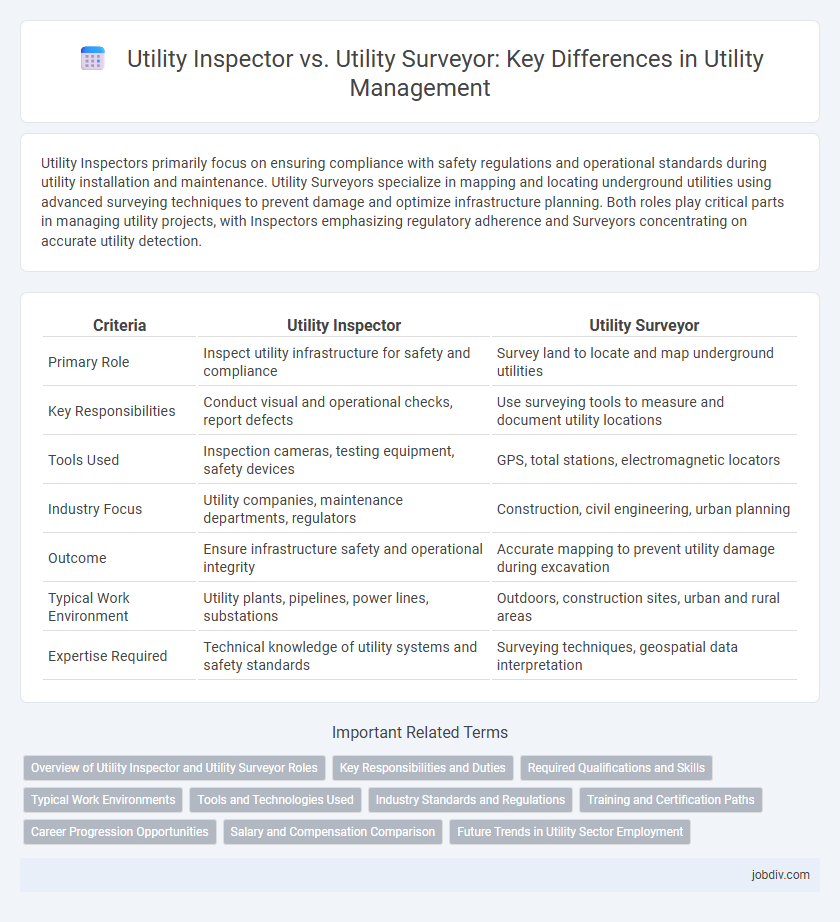Utility Inspectors primarily focus on ensuring compliance with safety regulations and operational standards during utility installation and maintenance. Utility Surveyors specialize in mapping and locating underground utilities using advanced surveying techniques to prevent damage and optimize infrastructure planning. Both roles play critical parts in managing utility projects, with Inspectors emphasizing regulatory adherence and Surveyors concentrating on accurate utility detection.
Table of Comparison
| Criteria | Utility Inspector | Utility Surveyor |
|---|---|---|
| Primary Role | Inspect utility infrastructure for safety and compliance | Survey land to locate and map underground utilities |
| Key Responsibilities | Conduct visual and operational checks, report defects | Use surveying tools to measure and document utility locations |
| Tools Used | Inspection cameras, testing equipment, safety devices | GPS, total stations, electromagnetic locators |
| Industry Focus | Utility companies, maintenance departments, regulators | Construction, civil engineering, urban planning |
| Outcome | Ensure infrastructure safety and operational integrity | Accurate mapping to prevent utility damage during excavation |
| Typical Work Environment | Utility plants, pipelines, power lines, substations | Outdoors, construction sites, urban and rural areas |
| Expertise Required | Technical knowledge of utility systems and safety standards | Surveying techniques, geospatial data interpretation |
Overview of Utility Inspector and Utility Surveyor Roles
Utility Inspectors oversee the inspection and maintenance of utilities like water, gas, and electricity to ensure compliance with safety regulations and operational standards. Utility Surveyors specialize in mapping, locating, and assessing underground and overhead utility infrastructure, using advanced surveying technologies such as GIS and GPS for precise data collection. Both roles are critical for utility management, with Inspectors focusing on safety and functionality while Surveyors provide accurate spatial data for planning and development.
Key Responsibilities and Duties
A Utility Inspector is responsible for examining and ensuring compliance with safety regulations, inspecting utility installations, and monitoring maintenance work to prevent hazards. A Utility Surveyor conducts detailed surveys and mapping of utility infrastructure, assesses land and utility asset conditions, and provides data for planning and development projects. Both roles are essential for maintaining the integrity and safety of utility systems, with inspectors focusing on safety enforcement and surveyors on data collection and analysis.
Required Qualifications and Skills
Utility Inspectors require a high school diploma or equivalent, with additional technical training or certification in utility systems, safety standards, and regulatory compliance. Utility Surveyors typically need a degree in surveying, civil engineering, or a related field, along with proficiency in Geographic Information Systems (GIS), surveying instruments, and data analysis. Both roles demand strong analytical skills, attention to detail, and knowledge of local utility codes and safety protocols.
Typical Work Environments
Utility Inspectors typically work in urban and industrial settings, conducting on-site inspections of electrical, gas, and water utilities to ensure safety and compliance with regulations. Utility Surveyors often operate in a variety of outdoor environments, including rural and undeveloped land, where they perform land surveys to map utility lines and plan new infrastructure projects. Both professionals frequently collaborate with utility companies, construction teams, and government agencies in office and field settings to support utility management and development.
Tools and Technologies Used
Utility Inspectors utilize handheld devices such as ultrasonic detectors, ground-penetrating radar, and mobile apps for real-time data collection and asset condition monitoring. Utility Surveyors employ advanced surveying instruments including total stations, GPS receivers, and LiDAR technology to create precise utility maps and 3D models. Both roles leverage Geographic Information Systems (GIS) for data integration and spatial analysis, enhancing infrastructure management and decision-making processes.
Industry Standards and Regulations
Utility inspectors ensure compliance with industry standards and regulations by conducting thorough inspections of utility infrastructures to identify safety hazards and operational deficiencies. Utility surveyors specialize in mapping, measuring, and assessing utility assets using advanced geospatial technologies to support accurate documentation and regulatory reporting. Both roles are critical for maintaining adherence to federal and state utility regulations, including OSHA standards and environmental compliance mandates.
Training and Certification Paths
Utility Inspectors typically undergo formal training programs focused on safety regulations, compliance standards, and inspection techniques, often culminating in certifications like OSHA Safety Certification or NACE Coating Inspector credentials. Utility Surveyors receive specialized education in mapping technologies, geographic information systems (GIS), and land surveying, with certifications such as the Certified Utility Locator or Professional Land Surveyor (PLS) license. Both roles require continuing education to stay updated with industry standards, but Utility Inspectors emphasize regulatory compliance, while Surveyors focus on precise utility location and mapping accuracy.
Career Progression Opportunities
Utility Inspectors typically start with field inspections, ensuring compliance with safety and technical standards, and can progress to supervisory roles or specialized inspection positions. Utility Surveyors often begin by mapping and analyzing utility networks using advanced geospatial technologies, leading to project management or consultancy roles focused on infrastructure planning and development. Career progression in both paths depends on acquiring technical certifications and gaining experience in emerging utility technologies such as smart grids and renewable energy systems.
Salary and Compensation Comparison
Utility Inspectors typically earn an average salary ranging from $50,000 to $70,000 annually, reflecting their responsibilities in ensuring compliance with safety and operational standards. Utility Surveyors, on the other hand, often command higher compensation, with salaries averaging between $60,000 and $85,000, due to their specialized skills in mapping and analyzing utility installations. Benefits and bonuses in both roles vary based on geographic location, employer size, and individual experience, influencing overall earnings significantly.
Future Trends in Utility Sector Employment
The utility sector is experiencing a shift with increasing automation and smart grid technologies, altering the roles of Utility Inspectors and Utility Surveyors. Utility Inspectors will need advanced skills in digital monitoring and AI-driven diagnostics, while Utility Surveyors will focus more on geospatial data analysis and remote sensing technologies. Emerging trends highlight a demand for hybrid expertise combining traditional inspection methods with innovative tech proficiency to enhance utility infrastructure management.
Utility Inspector vs Utility Surveyor Infographic

 jobdiv.com
jobdiv.com